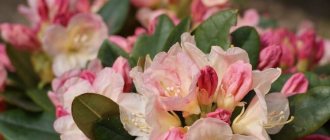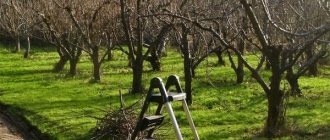In this article we will look at the types of shrubs that can decorate your area.
Ornamental shrubs decorate the garden and solve several important problems at the same time. Thanks to them, you can divide space into zones, create a living fence or border, and hide unsightly places.
To make your site look beautiful all year round, choose shrubs of different heights, flowering and fruiting periods, taking into account their resistance to weather conditions.
Garden shrub rhododendron with pink flowers
Rhododendron is a genus of beautiful flowering plants in the Ericaceae family. Some are tropical sissies (indoor azaleas), others can withstand harsh climates well. About 18 species are found in Russia, and we have made a selection of frost-resistant rhododendrons for growing in gardens.
This ornamental crop is a garden shrub with pink flowers or small trees that can be evergreen, deciduous or semi-evergreen. The bare or slightly pubescent branches are covered with harsh and dense leaves.
Quite large flowers, resembling bells, are arranged singly or in inflorescences such as a shield or umbrella. The color of the inflorescences can vary from snow-white and yellow to brownish-purple. Below are frost-resistant types of garden rhododendrons that are used in landscaping and landscaping.
Yellow rhododendron is a deciduous species. Under natural conditions, this shrub with pink flowers can be seen in the North Caucasus. Cultivated since 1972. The height of this spreading beautiful shrub varies from 2 to 3 meters. Dense elongated leaves, painted in a bright green shade, become dark red or orange-red with the onset of autumn.
Pink, very fragrant flowers bloom at the tops of shoots in multi-flowered inflorescences such as a corymb or umbrella. Flowering occurs from April to May, when the leaves bloom. It lasts from three to four weeks.
This species has a large number of varieties, the flowers of which are painted in a variety of attractive shades. Hybrids with double inflorescences have also been created.
Yellow rhododendron reproduces both by seeds and by layering. It has its most spectacular appearance during lush spring flowering and in autumn, when the leaves change color.
Rhododendron ponticus. Under natural conditions, this shrub with pink flowers grows on the Caucasian coast of the Black Sea. Beautiful elongated, harsh leaves with a glossy surface are painted in a deep green color. They are located at the ends of the branches of this evergreen shrub in the form of cuffs.
Large purple-pink flowers with showy yellow dots can reach almost 5 cm in width. They bloom in corymbose-type inflorescences consisting of a large number of flowers. During the flowering period, which lasts almost 4 weeks, you simply cannot take your eyes off this original shrub.
This species is propagated by seeds, cuttings and layering, but the simplest method is propagation using leaf cuttings.
Rhododendron Ledeboura (maral). In nature it grows among piles of stones and screes. It can be found in the Sayan Mountains and Altai. The crown of this semi-evergreen shrub (about 2 m in height) is formed by numerous thin branches. Small oval leaves mainly overwinter on shoots.
Attractive pinkish-lilac flowers with open petals (about 5 cm wide) are located almost at the very tops of the branches, one or several pieces together. The annual abundant flowering occurs in the month of May. At this time, the bushes are almost completely covered with flowers.
This fast-growing species of rhododendron tolerates transplantation well when young. It can be easily propagated using seeds.
Heat-loving shrubs with pink flowers
The heat-loving shrubs with pink flowers discussed below in central Russia can be grown as container crops. In summer they can be taken out into the garden, and in winter they can be grown in warm rooms at home or in a city apartment.
Look at the names of shrubs with pink flowers, and the photos will help you make the right choice.
Azalea
Azalea is one of the most spectacular flowering shrubs with pink flowers that turn the garden into a vibrant show of color in spring and early summer. From year to year, the culture is becoming more and more popular, and breeders are creating more and more new and unusual varieties. Today, there are more than a hundred hybrids and varietal forms of garden azaleas, caring for which in open ground is not as difficult as many people believe.
Among the highly decorative species, large-flowered and Japanese azaleas are popular.
Deciduous (large-flowered) varieties are characterized by tall growth and large flowers of various shapes. Flowering period is late May and early June. The most popular winter-hardy varieties: “Chanel”, “Freya”, “Klondike”, “Tunisia”, “Sonya”, “Starus”, golden “Golden Lights” and “Golden Sunset”, one of the most beautiful late-flowering varieties, bright orange “ Gibraltar".
Variety "Gibraltar". Japanese azaleas are characterized by slow growth and a more compact bush shape, not exceeding 60-100 cm. There are dwarf varieties no more than 30 cm in height. A shrub with pink flowers that grows wider rather than higher, so it can be used as a ground cover. Flowers delight gardeners in all shades of pink, lilac and purple. The leaves usually fall off in the winter, but not on all varieties. Several popular varietal forms: “George Arendes”, “Kermezina”, “Rosinetta”, “Silvester” “Rubinstern”, “Marushka”, “Blue Danube”.
Variety "Blue Danube". The duration of flowering, depending on the type and variety, varies from 3 weeks to 2 months, and the crop blooms for the first time in the 3rd year.
Garden hibiscus (Syrian)
Hibiscus is a bright representative of the Malvaceae family. The genus has about 300 species. This is a tropical plant. Its homeland is the tropics and subtropics of the Old and New Worlds. In the middle zone, only a few types of hibiscus are grown. Among them is the Syrian hibiscus. If this shrub with pink flowers is covered for the winter or wintered in the basement, the flower will take root and will delight with lush flowering even in regions with cold winters.
China is considered the birthplace of the Syrian hibiscus. In its natural environment, the size of the plant reaches 5-6 meters. As a rule, deciduous shrubs are grown in the garden, reaching a height of 1.5 meters. It has bright green ovate leaves and single flowers of various colors. The plant can also be grown as a standard tree.
Garden hibiscus is an unpretentious plant. The owners will not have any special troubles with it. It's easy to care for. When new green shoots appear, cut off old, dried stems. Hibiscus does not tolerate weeds in the neighborhood. It is necessary to ensure that the bush does not thicken and regularly pull out weeds.
Garden hibiscus is a light-loving plant. In order for it to delight with abundant and lush flowering, it should be placed in a well-lit place. It will look great next to roses. Thanks to its compact size, it fits perfectly into any rose garden. As a single plant it is no less attractive. It is very good to plant lavender bushes next to hibiscus. It is not only beautiful, but also useful. The scent of lavender repels aphids, which love roses and hibiscus. The plant does not tolerate drafts, so it must be protected from the wind.
When choosing a plant for planting, you should take into account that non-double varieties of garden hibiscus are more frost-resistant. Flowers with double petals are afraid of frost.
What plants can be planted in the shade at the dacha
Often there are empty places on the site where shadow or partial shade is created throughout the day. And many novice gardeners are puzzled about what plants can be planted in the shade at the dacha. But there is an answer to this question too. Below are shade-loving shrubs for the garden, which are also perennial and unpretentious:
- Euonymus. Looks especially beautiful in autumn. It is impossible to pass by such a bush, as if blazing with fire;
- derain This shrub is also suitable for shady places. You can plant along fences, which will make the area look even better;
- barberry. His description says that low-growing varieties can be planted under trees, and those that grow tall enough will look good near the house;
Shade-tolerant shrubs for the garden
- viburnum. Shade-tolerant shrubs are also unpretentious in care. Looks very attractive in the autumn;
- snowberry. As you know, during the period when its berries begin to ripen, the bush looks simply amazing. In addition, it can be planted in shade or partial shade;
- Mahonia. The evergreen plant is not only shade-tolerant, but also winter-hardy. In addition to this, the shrub survives drought well;
- elder. Unpretentious perennial shrubs can grow in sunny areas and in shaded areas;
- wintergreen Slow growing shrub, but blooms beautifully. Will grow for 50 years.
Wintergreen
Shade-loving shrubs are an excellent solution for those who want to improve their area, which is partially or completely shaded. These plants not only allow you to decorate the area in spring, summer, but also in autumn.
The garden looks very beautiful, in which various types of bush plants are planted. From the onset of the flowering period until frost, the area will be buried in flowers. One shrub will fade, and it will be the turn of another ornamental plant to delight with the splendor of flowers. The main thing is to choose the right species and varieties and provide decent care.
Interesting types of shrubs blooming pink
There are other types of interesting shrubs that bloom pink - most of them can be seen in parks and even forests.
Rosehip May
Rose hips are considered the best remedy for strengthening the immune system and protecting against infections due to its high content of vitamin C
- Synonym: Cinnamon rose hip.
- Latin name: Rosa majalis
- English names: double cinnamon rose.
- Common names: wild rose, cinnamon rose.
- Family: Pink
- Parts used: fruits, leaves, flowers, branches, roots.
Botanical description: perennial deciduous shrub with pink flowers up to 2 m high. It has twig-like branches covered with shiny brown-red bark. The shoots are covered with sparse thorns; flowering shoots are usually without thorns. A winter-hardy and unpretentious plant, used for urban landscaping. The leaves are imparipinnate, with 3-7 pairs of elliptical leaflets. The flowers are large, fragrant, from pale red to dark red. It blooms from May to July, the fruits ripen in August. The fruits are spherical or ovoid.
Habitat. Grows throughout almost all of Russia, with the exception of the southern steppe regions and Crimea, throughout the European part with the exception of the northern, Black Sea and Caspian regions, in Western and Eastern Siberia to Lake Baikal in forests, among bushes, along thickets near lakes, rivers, in meadows
Lovely collection
Among the ornamental shrubs that bloom in pink, in the country house or in the garden, the charming columbine is not so common. But whoever sees it blooming for the first time will definitely try to place it on his site. It’s not for nothing that kolkvitsia is also beautiful in the botanical sense. Her full Latin name is Kolkwitzia amabilis, where "amabilis" translates as "lovely", "pleasant", "sweet".
This beautifully flowering shrub comes from the mountainous part of Central China and is found in Manchuria. It is part of the Honeysuckle family of the genus Kolkvitsia. Among the botanical relatives of Colquitia are weigella, honeysuckle, and snowberry.
The genus was named in honor of the German botanist Richard Kolkwitz; it includes only one species - Kolkwitzia charming. Colquitia came to Europe at the beginning of the twentieth century (1901), and its first flowering here occurred in 1910. Soon the bush began to be planted en masse in gardens and parks. After 1914, the lovely colquitia crossed the ocean and also fell in love with American gardeners, remaining for several years the main decoration of their gardens. And the British were so delighted with the flowering of the colquitia and its simple maintenance that in 1923 they awarded it the Royal Horticultural Society award for services to gardening. What kind of charming woman charmed two continents at the same time?
This plant is a perennial shrub with pink flowers ranging from 1.5 to 3 meters in height. The small plant is covered with small hairs. An adult shrub has no hairs; it is covered with red-brown bark that peels off in plates. In the spring, green leaves up to 7 cm long, pointed towards the edge, appear on the kolkvitia; in the fall they turn yellow, and fall off by winter. The bush grows with several trunks, and abundant basal shoots appear annually. At first the shoots grow straight, then they bend in an arc, leaning towards the ground. Flowering occurs in the second year of planting in the ground in mid-summer. Colquitia buds are paired and are located at the ends of the branches; the flowers are pinkish-white with a pearlescent sheen. Among the flowering shrubs, the following also look beautiful: Manchurian aralia, magnolia, forsythia, lilac, Japanese spirea, rhododendron, hibiscus, heather and abelia. The fruits are round capsules covered with bristles; they ripen in late autumn. Kolkwitzia fruits Varieties and species In cultivation, this shrub is represented in a single form, Kolkwitzia amabilis - lovely kolkwitzia. The translation of the species name has many variations, including “gracious”, “pleasant”, “dear to the heart”. There are two varieties of this shrub: “Rosea” - with flowers of rich dark pink color; "Pink Cloud" - with creamy pink flowers.
Camellia is a perennial shrub with pink flowers.
Camellia (Camellia) is an evergreen plant belonging to the Tea family. This amazing perennial shrub with pink flowers was named after the Jesuit monk Camelius Georg Joseph, who first brought it to Europe. In the wild, the plant grows in tropical and subtropical zones in countries such as Japan, Korea, Malaysia, the Philippines, India, China, on the islands of Java, and Sulawesi.
Surely the description of the camellia flower will be of interest to many florists. This beautiful plant is a shade-tolerant bush or tree, the height of which can vary from 2 to 20 m. Blunt or pointed leaves have a simple, elliptical, broad or oblong-ovate shape, a leathery structure, a glossy surface, and short petioles. They can be single or sequential. The length of the leaf plate is about 3 - 17 cm.
It is imperative to get an answer to the question of what this shrub looks like with pink flowers. Camellia produces many single buds. The diameter of blossoming flowers with numerous stamens can vary from 1 to 12 cm. The petals are fused at the base. Their color can be pink, red, white, variegated.
Concerned with the question of what camellia smells like, you should find out that its flower, which looks like a beautiful rose, has no aroma. The fruit is a dry capsule, usually divided into 5 sectors containing seeds.
Popular types of camellia. Modern breeders have developed numerous varieties and camellia hybrids, using different varieties of the plant as a basis. Below are the most popular types.
Camellia japonica
This variety of shrub with pink flowers is considered the most famous, often used in breeding activities for the purpose of breeding indoor flowers. In the Land of the Rising Sun, this plant is revered on a par with the iconic sakura. The magnificent Japanese camellia flower (Camellia japonicaa) is cultivated as an indoor, greenhouse, and garden flower. It is often used as interior decor and for making bouquets.
Under natural conditions, the plant can have a height of 1.5 - 11 m. By caring for Japanese camellia at home, you can count on getting a tree-like shrub with stems up to 1 m long, blooming in November - January. Semi-double, double spherical flowers can have white, pink, red colors. In hybrid specimens, the petals often have a spotted or striped color. Flowers form in the leaf axils and cover the entire crown.
Camellia sinensis
This variety also has another name - tea bush. The leaves of the plant are used to produce green, black, and long tea. Dried flowers are components of various aromatic additives.
If you are interested in the question of where Chinese camellia (Camellia sinensis) grows, you can find out that the plant is industrially cultivated in many countries: China, India, Kenya, Japan, Georgia, etc. Our state is also engaged in the cultivation of tea camellia (Krasnodar region). Its cultivation indoors is quite rare.
Mountain camellia
Mountain camellia (Camellia sasanqua) grows naturally on the islands of Kyushu, Okinawa (Japan). In a cool room, it is fashionable to observe its flowering in the period November - February. The species is often taken as a basis when breeding indoor and garden varieties. The plant develops single buds or rosettes with 2 - 3 flowers. The red camellia flower looks very impressive; also, the petals can be white or pink.
Camellia saluyonskaya
This species is actively used in breeding cold-resistant varieties suitable for garden and greenhouse cultivation. A weakly branched shrub with pink flowers reaches a height of 1.5 m. Large flowers (8 cm in diameter) gradually bloom on it, the color of which can be snow-white, pink, dark red, burgundy. Saluen camellia (Camellia saluenensis) is considered the most unpretentious of the garden plants of its family.
Camellia oleifera
The cultivation of this evergreen tree, about 10 m high, is practiced in the Chinese mountainous regions. Large seeds of the Camellia oleifera flower are formed in a large fruit capsule. Single bisexual or paired axillary flowers are characterized by the presence of a white color.











